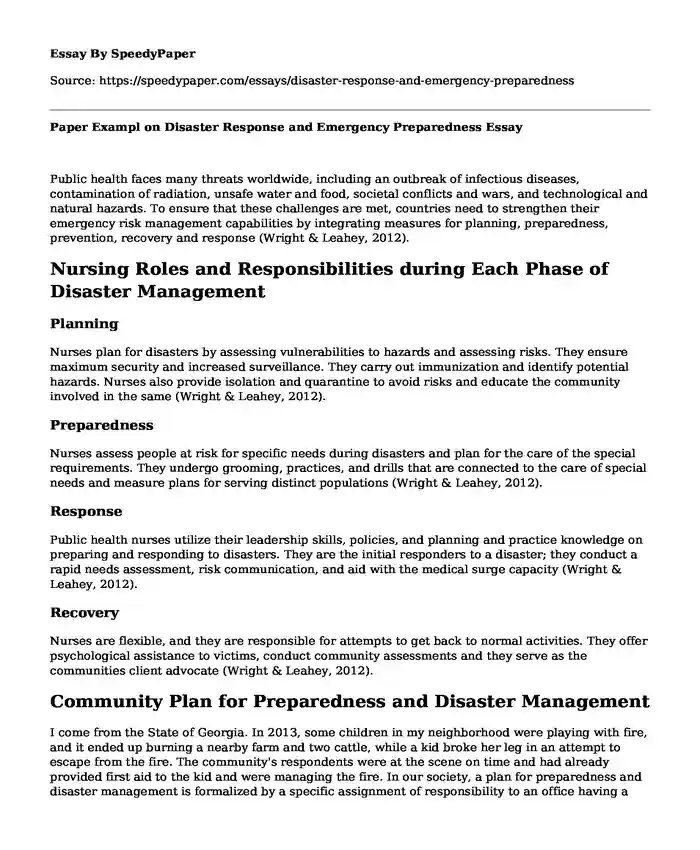
| Type of paper: | Essay |
| Categories: | Disaster Public health Nursing care Stress management |
| Pages: | 3 |
| Wordcount: | 686 words |
Public health faces many threats worldwide, including an outbreak of infectious diseases, contamination of radiation, unsafe water and food, societal conflicts and wars, and technological and natural hazards. To ensure that these challenges are met, countries need to strengthen their emergency risk management capabilities by integrating measures for planning, preparedness, prevention, recovery and response (Wright & Leahey, 2012).
Nursing Roles and Responsibilities during Each Phase of Disaster Management
Planning
Nurses plan for disasters by assessing vulnerabilities to hazards and assessing risks. They ensure maximum security and increased surveillance. They carry out immunization and identify potential hazards. Nurses also provide isolation and quarantine to avoid risks and educate the community involved in the same (Wright & Leahey, 2012).
Preparedness
Nurses assess people at risk for specific needs during disasters and plan for the care of the special requirements. They undergo grooming, practices, and drills that are connected to the care of special needs and measure plans for serving distinct populations (Wright & Leahey, 2012).
Response
Public health nurses utilize their leadership skills, policies, and planning and practice knowledge on preparing and responding to disasters. They are the initial responders to a disaster; they conduct a rapid needs assessment, risk communication, and aid with the medical surge capacity (Wright & Leahey, 2012).
Recovery
Nurses are flexible, and they are responsible for attempts to get back to normal activities. They offer psychological assistance to victims, conduct community assessments and they serve as the communities client advocate (Wright & Leahey, 2012).
Community Plan for Preparedness and Disaster Management
I come from the State of Georgia. In 2013, some children in my neighborhood were playing with fire, and it ended up burning a nearby farm and two cattle, while a kid broke her leg in an attempt to escape from the fire. The community's respondents were at the scene on time and had already provided first aid to the kid and were managing the fire. In our society, a plan for preparedness and disaster management is formalized by a specific assignment of responsibility to an office having a budget that is easy to identify. The response plan and procedures for our community and actions taken by our community is written down as follows;
- Emergency supplies
- Radio
- Flashlight
- Food
- Water
- First aid kit
- Mitigation
- Rearrangement of cupboards
- Keeping matchsticks and flammable materials out of children's reach
- Training/ Planning
- First Aid training
- Earthquake insurance
- Obtaining neighbor contacts
- Educating children
- Attending community meetings
- Recovery
- Elected seniors and appointed officials
- Established priorities for disaster recovery
The public health, health care, the emergency management team, and the emergency medical services work together to offer the right care at the right time.
These procedures are for respondents with dependent children and homeowners, and those with disabilities, since they are calculated according to the community's budget.
The Plan for Addressing Mass Casualty Situations
Victims of mass casualty incidents suffer disabilities of health impairment and psychological and physical problems. In such events, the community provides the first support. Planning emphasizes that the community should build on the infrastructure and stay organized at all levels (Nies & McEwen, 2001). Health authorities, including; the nation and other sectors need to be actively involved in empowering communities, in developing emergency management plans for mass casualty incidents. A society that has lost many loved ones will need a program that includes;
Communication planning-insightful communication plans amongst emergency and health management agencies should be initiated. The goal of this is to execute systems and procedures that will be understood by those who will practice them.
Emergency and trauma care systems-the necessity for the provision of rapid care to casualties may need measures such as; reduced procedures for testing, more extensive staff-to-patient ratio, and relaxed documentation requirements.
Training and exercises based on a detailed plan for education for all staff and training, each healthcare facility must have its capacity to handle mass casualty incidents.
References
Nies, M. A., & McEwen, M. (2001). Community health nursing: promoting the health of populations. Elsevier Health Sciences. Retrieved from https://bookshelf.vitalsource.com/
Wright, L. M., & Leahey, M. (2012). Nurses and families: A guide to family assessment and intervention. FA Davis. Retrieved from https://bookshelf.vitalsource.com/
Cite this page
Paper Exampl on Disaster Response and Emergency Preparedness. (2023, Jan 16). Retrieved from https://speedypaper.com/essays/disaster-response-and-emergency-preparedness
Request Removal
If you are the original author of this essay and no longer wish to have it published on the SpeedyPaper website, please click below to request its removal:
- Essay Sample with a Big Government Counter Argument
- Essay Example: Sri Lanka as the Socialist Republic
- Free Essay on Scientific Methods of Research
- Essay Example about Acid Precipitation (Acid Rain)
- All Our Kin: Strategies for Survival in a Black Community - Book Review Essay
- Religion and Spirituality, Free Example for Everyone
- Paper Example on Mass Incarceration
Popular categories




